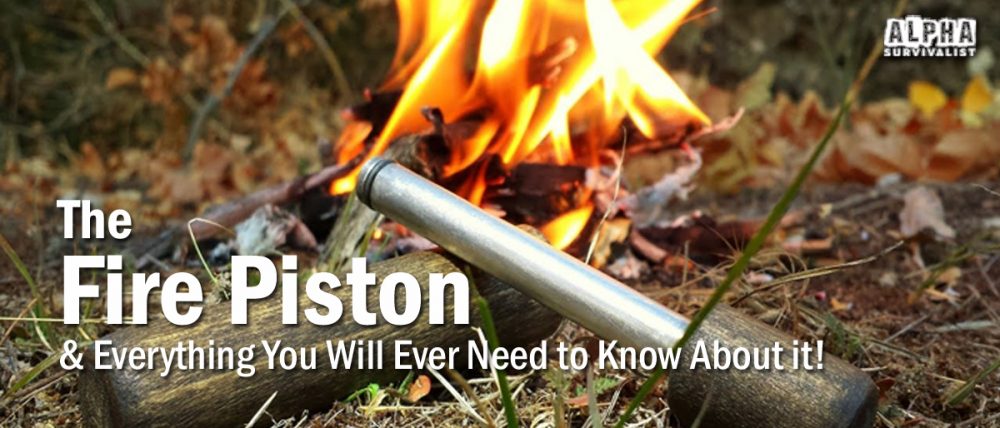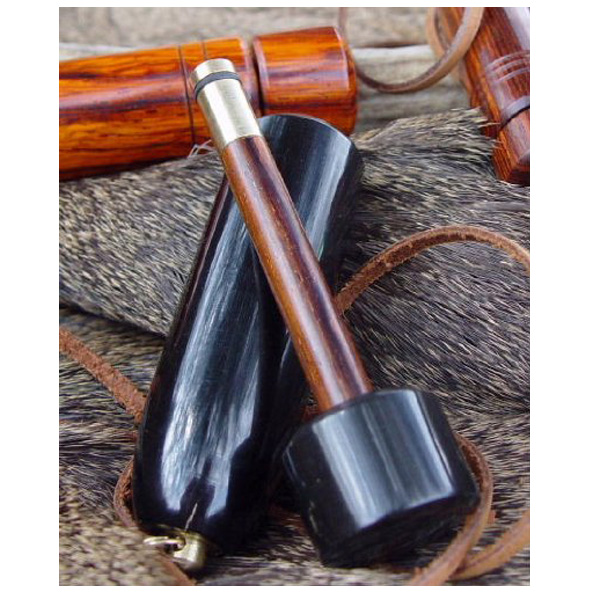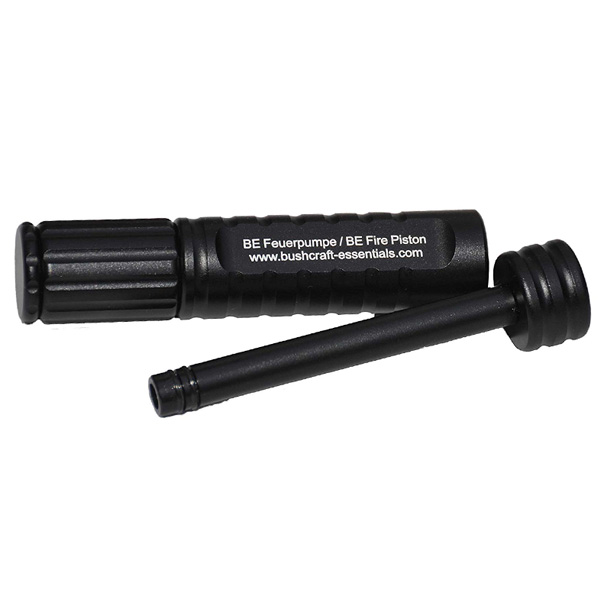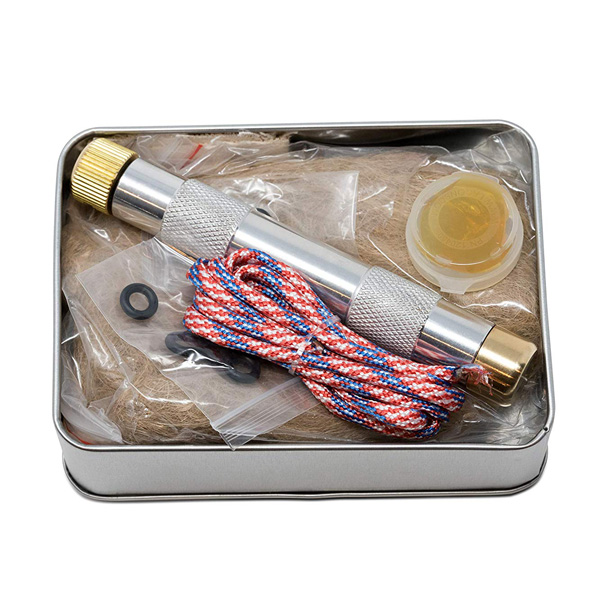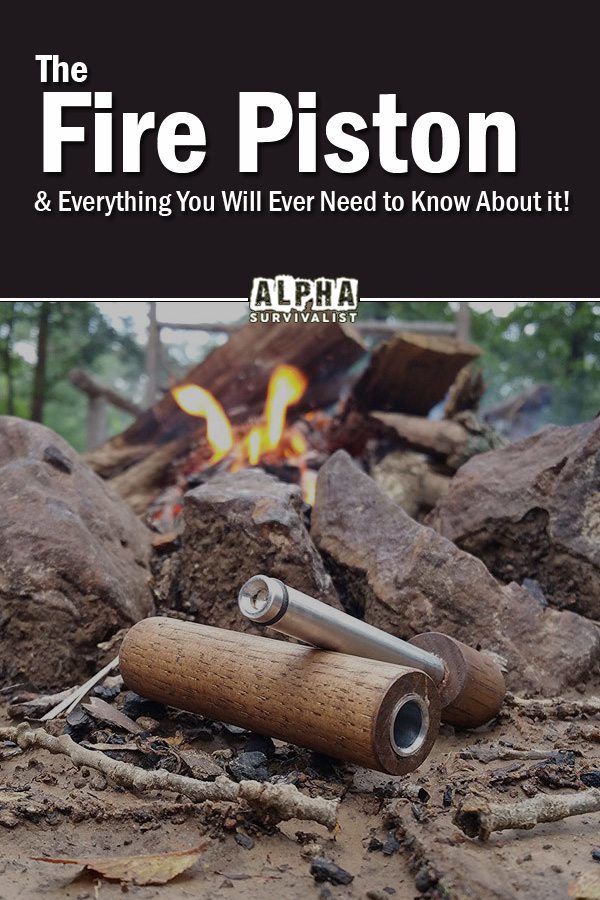
What is a Fire Piston?
Although fire piston is the commonly used name used for this device it has also been called a slam rod fire starter or a fire syringe.
Whatever name you call it, the fire piston is a simple enough device to understand and use.
It consists of a cylinder that’s sealed at one end and open at the other, and a piston with a small cavity at its end.
The piston should enter the cylinder easily with the addition of a tight but frictionless seal. This is important for easy operation.
In the cavity on the interior end of the piston a small piece of tinder is placed.
The piston has a handle on its exterior end. This handle can be used to press the piston into the cylinder safely and at high speed.
As the piston is rapidly pressed into the cylinder, it increases the air pressure inside the cylinder which leads to a rapid increase in temperature.
Fire pistons use the principle that compressed gas (in our case, air) can actually cause the ignition of a material such as tinder.
The temperature obtained is about 400 degrees, which is the ignition temperature of tinder.
Ignited tinder can then be used to build up a regular fire to keep you warm and safe, whilst also providing you with somewhere to cook your food.
Older versions of the cylinder have been made from wood, bamboo or even animal horns. Modern fire pistons are frequently made of PVC, plastic, and metal.
How to use a Fire Piston?
To use a fire piston to create fire, you need to have some dry tinder, and some dry firewood.
Placing a small amount of tinder on the end of the piston it is rapidly pushed into the cylinder and then extracted.
The small amount of tinder inside the fire piston is used to light a larger pile of tinder.
Once your larger mound of tinder has caught fire you can add firewood and build up your fire to the desired size and temperature.
Note: Char cloth is by far the most effective tinder to use inside the piston as it retains heat longer. This will give you a better chance of starting a fire first time.
Fire pistons are not a new concept. The idea of using compression to create fire has been used for hundreds of years in some cultures.
Which is the Best Fire Piston?
The honest answer to that question is it is down to personal preference. Some people prefer fire pistons made out of hard woods or other natural materials like bull horn for example. Others prefer the accuracy of machined metal fire pistons. Some prefer heavier pistons to lighter ones, bulkier to more streamlined, but whatever your preference the most important and overriding factor has to be how well it works.
Here are a few good fire pistons that work EXCELLENTLY irrespective of shape, size, or material used;
The History of the Fire Piston and its South East Asian Origins
The fire piston could be deemed one of the more interesting tools in history. Its origins are shrouded in mystery, and even to this day it is unclear as to whether it was first developed in the West or much earlier, in South East Asia.
When did the First Fire Pistons Appear?
Despite many experts believing that the first fire pistons originated in South East Asia, the first official record for the production of fire pistons dates back to the 18th century, when Abbot Agostino Ruffo documented the first fire piston in Italy.
The story is that Ruffo was testing out some air guns for the King of Portugal, and he was checking to see if the air pump had any leaks. After noticing that the pressurized pump caused some small pieces of wood he had used to plug the air gun’s outlet to get scorched, Ruffo prepared an apparatus very similar to the modern day fire piston. His invention, however, was not popularized immediately.
Instead, it took another 57 years before the first fire piston became an acknowledged tool before scientists in 1802. After that, the “fire syringe” as it was initially called, became widely known once it was presented in England and France simultaneously in 1807. A reputable tool, the fire piston enjoyed widespread recognition during the 19th century, and some say it also inspired the invention of the diesel engine in 1892.
An Uncertain History
It is said that the indigenous people of South East Asia had already known about and used rudimentary versions of the modern day fire piston as early as the 16th century. If this is the case the it could be true that cultures in the Philippines, Laos and Thailand, among others, were aware of this design two centuries before the West even considered making the first tool!
The problem is that the rumors cannot be verified, and there are only clear reports that the tool was used in South East Asia in the 19th century, which makes it unclear whether it was first developed there, or brought to the area by trading ships.
On the other hand, if the fire piston was developed in South East Asia first, bringing it aboard goods ships to England would have left only a small window of opportunity to adapt the design to local materials and make it popular in the West. This is why most historians are highly sceptical that the design of modern fire pistons would have originated in areas like Burma, Laos or the Malay Peninsula.
Nevertheless, the South East Asian origins of the fire piston remain part of an interesting debate that many scholars continue to consider as a possibility.
How to Make a Fire Piston Ensuring an Airtight Fit
Making a fire piston is no easy feat. While the principal design and construction is quite simple, the work that goes into preparing the cylinder and piston to make sure you get an airtight seal can be quite challenging.
Turn a Brass Rod into a Piston
The first step should be to prepare your piston. For that purpose, you’ll need a brass rod that you can cut to a size of about 5 inches. In most cases, you won’t need it to be that long, and you can cut off the excess part when fitting the handle.
Next you’ll need to fit the O-ring on the piston to get a seal-tight fit that will allow it to slide in and out of the cylinder without allowing any air to exit. For this purpose, you need a triangle file that you can use to reduce the diameter of the rod to a thickness that will be able to fit the O-ring.
Finally, make a small hole in the part where you attached the O-ring, so you can add the tinder. After you finish, adding a tinder slit with the help of a file will finish the job and allow you to attach the tinder properly. At this point all you need is to add the handle, and you practically already have your piston.
Test for Air Leaks and Fire It Up
Once you’re done with the piston, it’s important to make sure there are no air leaks. To do that, just smear a little petroleum jelly on the O-ring and insert it carefully into the cylinder.
If you press the piston into the tube and it will just stay there motionless, then that’s a sign that there are air leaks and the fire piston won’t work. Spray the end of the plug with soapy water to see if any bubbles form and locate the air leaks. You can also adjust the depth of the O-ring and repolish the piston to make sure it’s a tighter fit. Once you notice that pushing the piston in creates resistance due to the increase in air pressure, you’re good to go.
VIDEO
How to Use a Fire Piston Safely
In order to use a fire piston safely, make sure you first understand how it works. In some cases, especially with a DIY fire piston, the cylinder can get hot, so it’s important to use gloves or set the piston in place without touching it, when you want to use it.
Also, as you pull out the piston from the cylinder, make sure to avoid touching the small piece of timber directly and have a safe location ready to build your fire. Make sure you avoid placing the piece of burning timber in an area where the fire can rapidly spread and lead to a forest fire. In most cases, it’s a good idea to make sure your fire will be isolated from the forest and landscape around by placing it inside a container or by putting small stones all around it.
Finally, make sure you don’t store your fire piston in a place where it can easily be accessed by children. Even though it’s relatively safe, a fire piston can still cause a lot of harm, and it should definitely be treated with respect, even and most especially in a SHTF situation, when there is already a lot of danger present.

